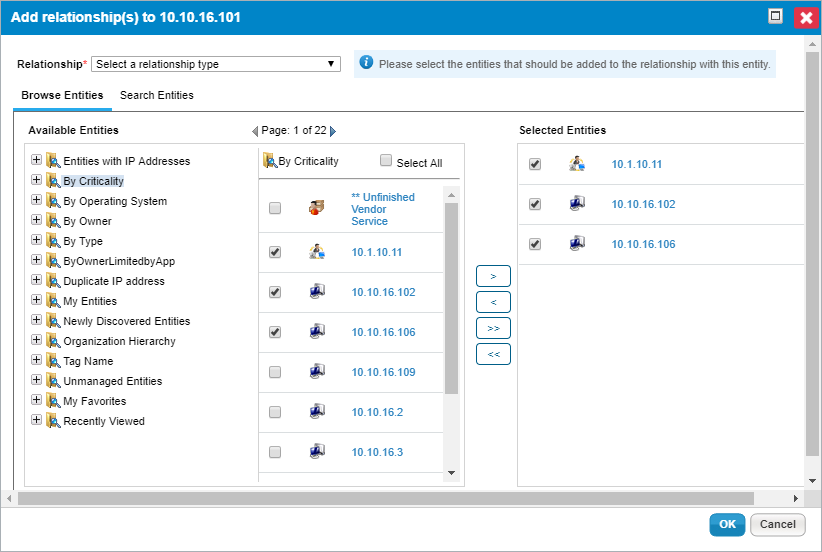Relationships can be defined between entities and entity collections.
Because entity relationships are always bi-directional, defining a relationship from one entity to another automatically defines the inverse relationship. When you define a relationship from one entity to another, two relationships are created. You can define a relationship between one source entity and more than one target entity, in which case several relationships are created. If you relate one source to three targets, six relationships are created.
For example, if you set the relationship of a user to 'Access to' an application, the system automatically adds the 'Accessed by' relationship to the application. Removing either 'Access to' or 'Accessed by' removes both definitions.
Relationships immediately affect assessments in progress and are visible in reports and dashboards the next time they run.
By default, control and score propagation settings are disabled. See Configuring Entity Relationship Attributes for more information.
| EXAMPLE |
| You want to establish a parent-child relationship between entity A and entity B. As an entity owner, you know that an entity A must be the parent of entity B. In this case, you must add a 'Child of' relationship type on the Relationship tab of entity B and select entity A. |
To establish a relationship between entities:
Go to Entities > Entities.
Click an entity to open.
Click the Relationships tab.
 The Relationships table on the Relationships tab.
The Relationships table on the Relationships tab.Click Add relationship.
 The Add relationships dialog.
The Add relationships dialog.Click Relationship and choose a relationship type.
Select an entity group in the Available Entities box, or click Search to find a particular entity using the search criteria. To specify search criteria, select a field in the first dropdown box, then select a condition in the second dropdown box, and enter the search value in the box. Click + to add a new search condition. Click Search to retrieve the results for selecting entity(s). To select specific entities, check the box next to entity(s), or dynamic group, or Select All.
Click OK.
The specified relationship is added, as well as the inverse relationship from the target(s) to the original entity.
When a relationship is established with a dynamic group or its member(s):
Selecting only specific entities within a dynamic group will create a relationship with only those entities.
Select All will create a relationship with all the selected entities within a dynamic group, but not the dynamic group. Therefore, when members are added or removed from a dynamic group, the relationship of those entities with the entity collection are not affected.
- Selecting dynamic group will create a relationship with dynamic group itself. This selection creates a dynamic relation with members of the dynamic group. You must be careful with this selection because when members are added or removed from a dynamic group, their relationship with other entities is affected.
Even though a member is shown on the Entities tab of entity collection, the Relationship tab will not show the EC Member or the Member of EC relationship type.
To remove a relationship:
Go to Entities> Entities and select an entity to open.
Click the Relationships tab.
Find a the relationship and click X in the Remove column.
Click OK .
The inverse relationship is automatically removed from the related entity.




